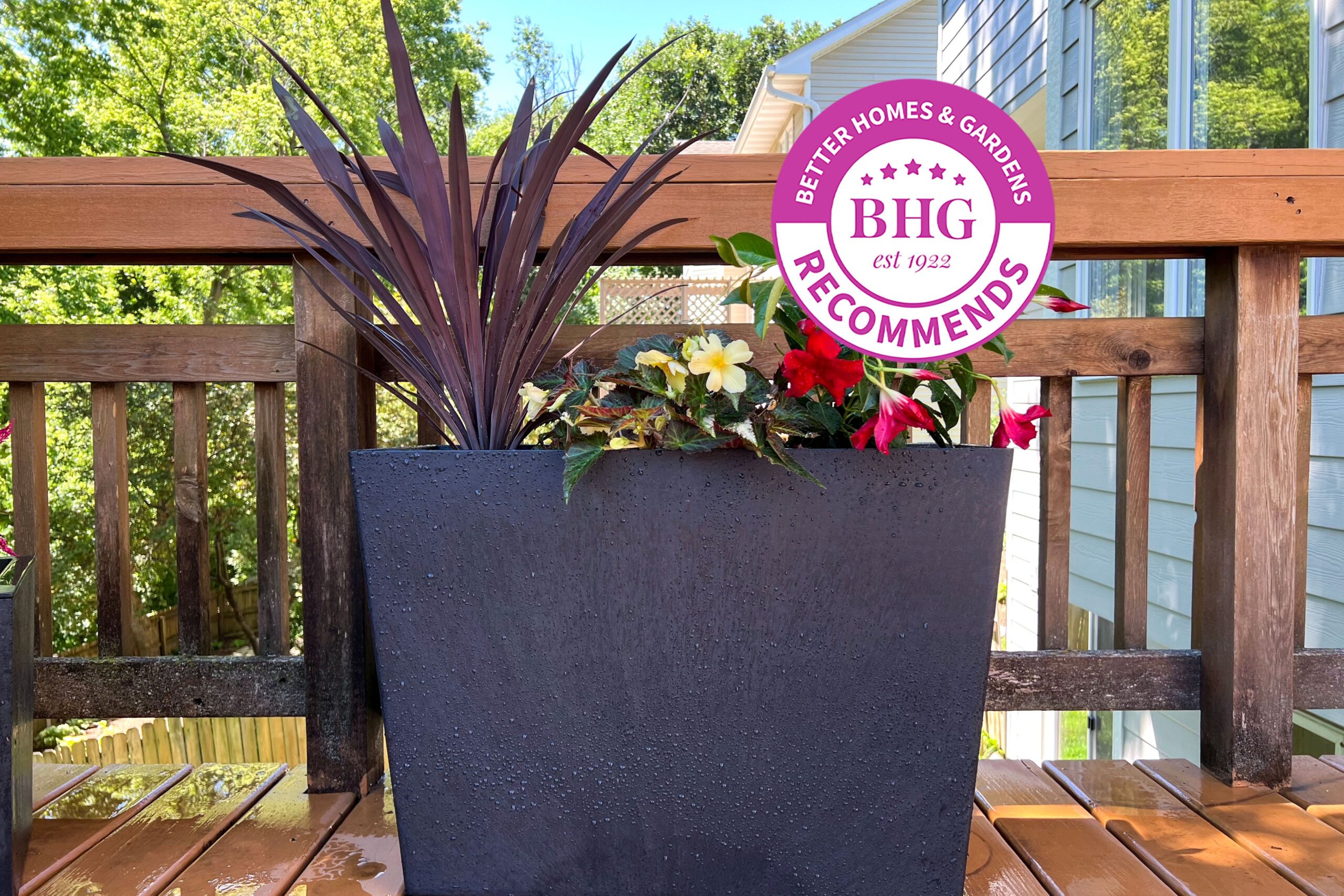If you happen to journey regularly or simply don’t have a inexperienced thumb, self-watering planters may be the answer to protecting your crops wholesome. To search out the most effective choices, we examined a dozen planters over the course of 4 months, noting how straightforward they had been to make use of and the way nicely our crops fared.
However how precisely do they work? “Self-watering pots work by capillary motion,” says Lisa Eldred Steinkopf, plant skilled of The Houseplant Guru. “The water reservoir on the backside of the planter is stuffed and the plant soaks it up from the underside. If a wicking materials is used, the wick attracts the water up into the plant. The plant dad or mum solely has to maintain the reservoir crammed with water in order that the plant can draw up the water.”
Whether or not you’re on the lookout for a dangling self-watering basket on your parched petunias or a big, hanging planter with an enormous water reservoir for a sunny deck, the checklist under has one thing for each gardener.
What We Advocate
We examined a dozen widespread self-watering planters available on the market in our properties, evaluating every primarily based on its effectiveness, design, ease of use, options, and worth. To study extra about how we examined self-watering planters, try our testing course of under.
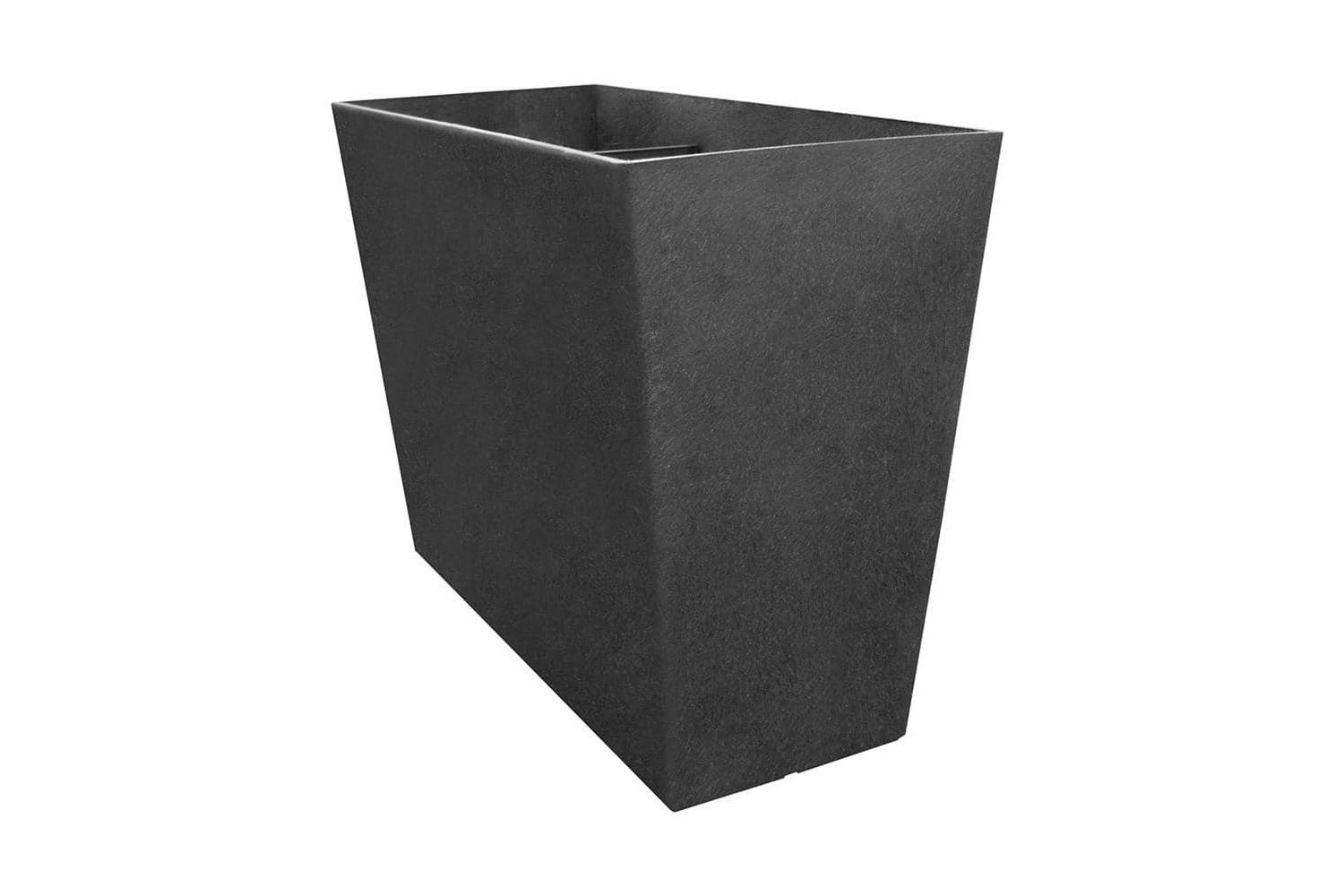
Although the Tierra Verde Sonata planter is produced from recycled tires, it has the high-end look of fiberglass. It is available in seven totally different shapes and sizes, so you’ll find the proper one on your area. We selected a basic rectangular design, which appeared trendy and blended nicely into our area.
This trough-style planter is nearly indestructible—they’re designed to withstand cracking and crumbling, even in freezing temperatures. The producer even offers a 365-day no-cracking assure. There have been no indicators of weathering or injury on the finish of the testing interval.
We breezed by the setup; all that’s required is to slip two divider panels into place, which assist help the construction of the planter. If utilizing open air, you’ll seemingly wish to take away the drainage plugs to make sure the planters don’t get water-logged in heavy rain.
To refill the reservoir, we merely watered the soil and extra water collected within the reservoir under. We had been very impressed at how these planters stored outside crops vibrant and wholesome, even in scorching 90 diploma climate. We refilled the water reservoir of those planters each week or so, although it may be troublesome to know when to refill due to the shortage of a water gauge.
Product Particulars: Sizes: 4, 10.3, 12, 14, 18, 24, and 28 inches | Materials: Recycled rubber | Indoor/Out of doors: Indoor and outside
Key Phrases to Know
- Wicking: Absorbing or drawing off liquid utilizing capillary motion. That is how crops absorb water in self-watering planters.
- Oxygen circulation: Oxygen circulation is essential for root well being. Many self-watering planters have drainage holes or different design options to encourage air circulation.
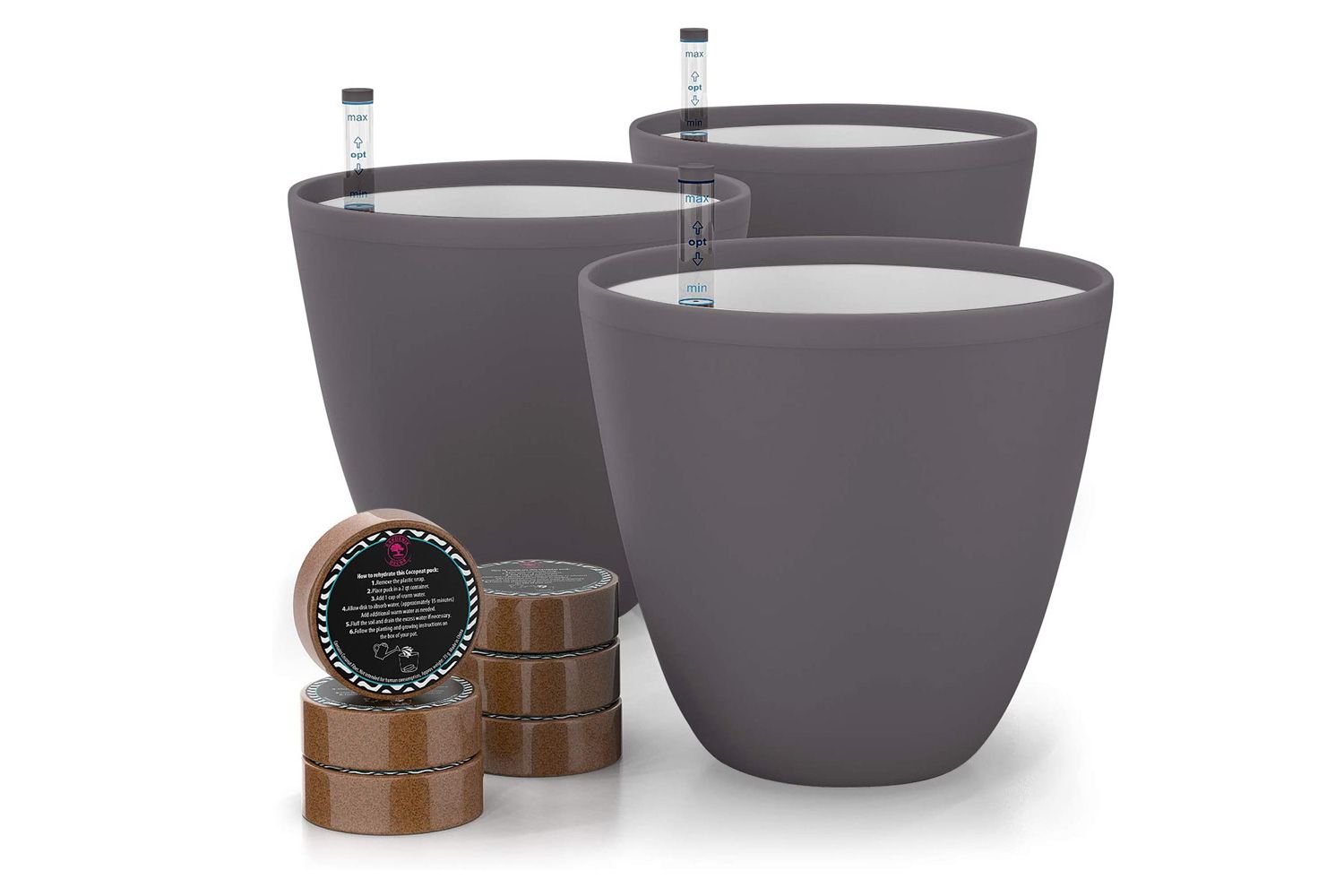
These pots from Gardenix are the most effective self-watering planters for the finances aware. The nested pot set has an inside plant holder with legs to make sure your crops are lifted above the water, which helps forestall root rot. These planters even have a water-level indicator that will help you know when it’s time to water.
This pot comes with coco coir soil as a part of the self-watering system. Coco coir is product of coconut shell fibers and is thought for its wonderful water retention and drainage. This planting medium helps guarantee your plant’s roots get oxygen in addition to water. The producer recommends you utilize common potting combine along with the coco coir.
We had been impressed by how straightforward this was to place collectively—it solely took three minutes to assemble by putting the inside pot into the outside pot and sliding the water indicator into place. To refill the reservoir, you merely pour water into the slot between the inside and exterior pots.
This pot is on the market in a number of colours: white, grey, purple, and teal. We liked that the pots didn’t appear like plastic, however famous that the fabric appeared like it might expertise weathering if used outdoors.
Product Particulars: Sizes: 7 inches | Materials: Plastic, polypropylene | Indoor/Out of doors: Indoor
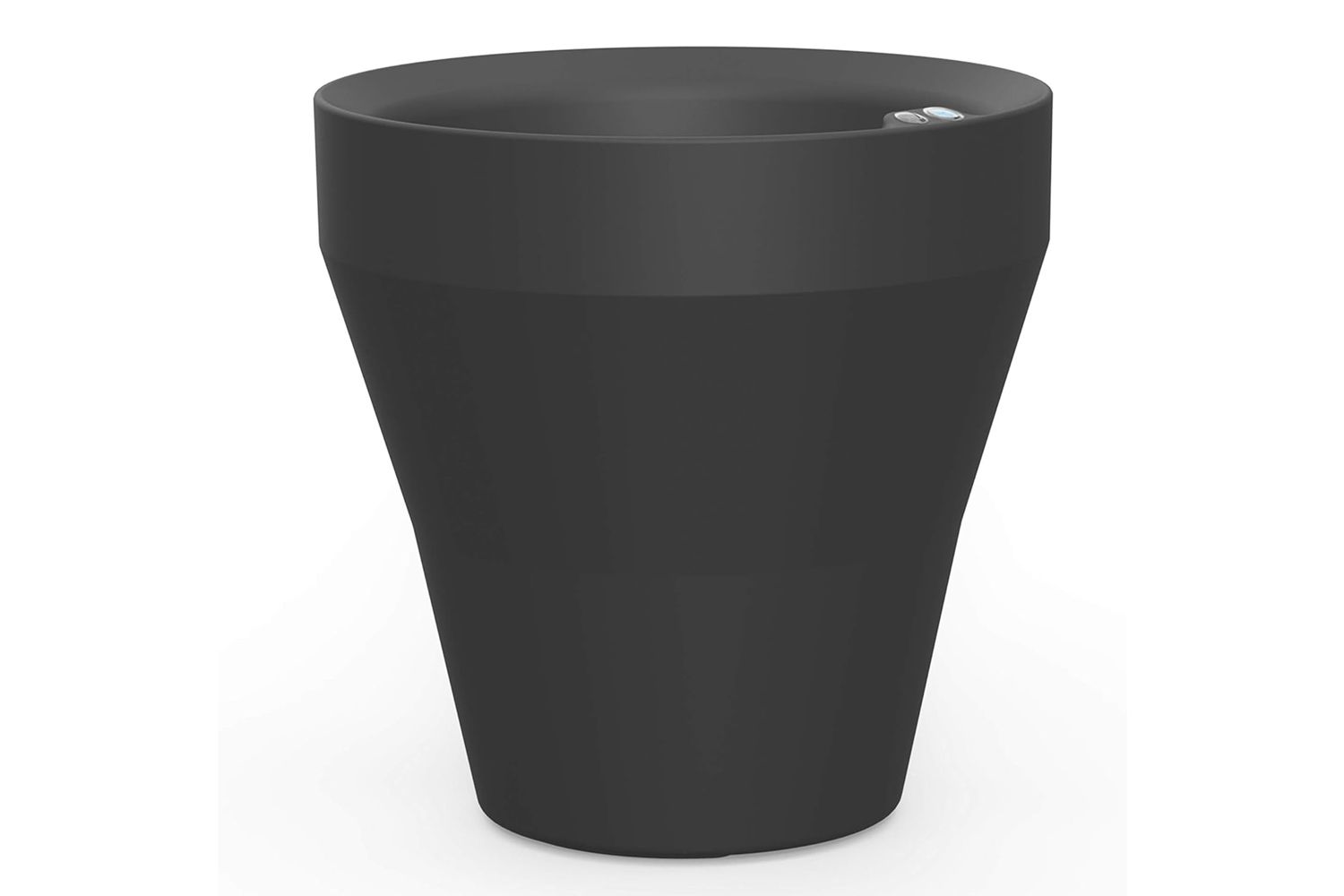
If you happen to’re seeking to splurge, we expect the Crescent Backyard pot is price it. The planter is designed with recycled, high-grade polyethylene to keep away from fading within the scorching summer time solar and cracking in chilly winters. Although it’s product of a heavy-duty materials, we discovered the planter surprisingly light-weight and simple to maneuver. The double-walled design helps shield plant roots from excessive temperature adjustments and likewise provides extra reservoir area for water. These planters are constructed to final and the producer provides a 10-year restricted guarantee.
You may go as much as six weeks with out watering with this planter, and it has a useful water stage indicator for straightforward monitoring. It is available in 4 sizes and 11 totally different colours in tasteful impartial shades. We preferred that this planter resembled a clay pot and that it got here prepared to make use of out of the field—it even consists of an instruction booklet with planting ideas and a plant styling information.
The reservoir was straightforward to fill from the rim of the planter; there’s a drainage gap and it is suggested to take away the crimson waterproof plug to forestall overwatering when utilizing open air. When the reservoir is full, a hidden overfill tube will drain out the surplus water, serving to to forestall root rot. The one draw back we observed was the value, however thought the top quality and longevity made it a worthwhile funding.
Product Particulars: Sizes: 18, 22, 26, and 30 inches | Materials: Excessive-density polyethylene | Indoor/Out of doors: Out of doors
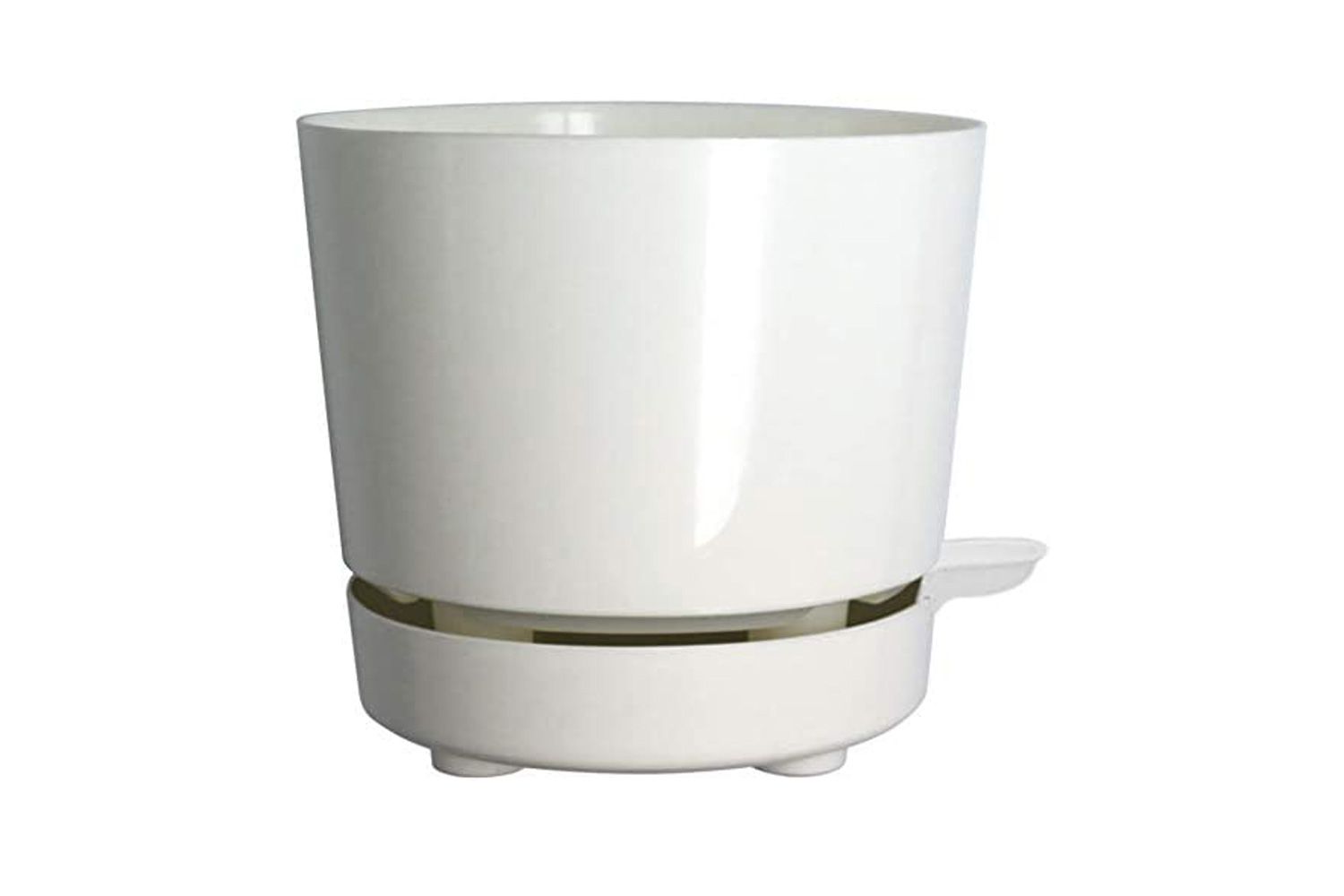
For a trendy indoor possibility, we suggest the HBServices planter. It encompasses a high pot with slotted cutouts on the underside and hole legs which can be inserted right into a reservoir. This design retains the roots above the water, serving to to forestall overwatering. The open slats on the underside of the pot additionally assist hold the roots oxygenated by encouraging air circulation, stopping root rot. To examine the water stage, merely elevate the highest as much as examine the water reservoir beneath.
The underside reservoir saucer is functionally designed, with risers that elevate it off the bottom to forestall water stains on the ground. We additionally preferred utilizing the handy watering clip to fill the reservoir.
Although this planter is product of plastic, it has color-fast properties and a shiny look that makes it seem much like ceramic. Nevertheless, it isn’t probably the most sturdy plastic, and it might crack or chip if dropped.
Product Particulars: Sizes: 8 inches | Materials: Plastic, polypropylene | Indoor/Out of doors: Indoor
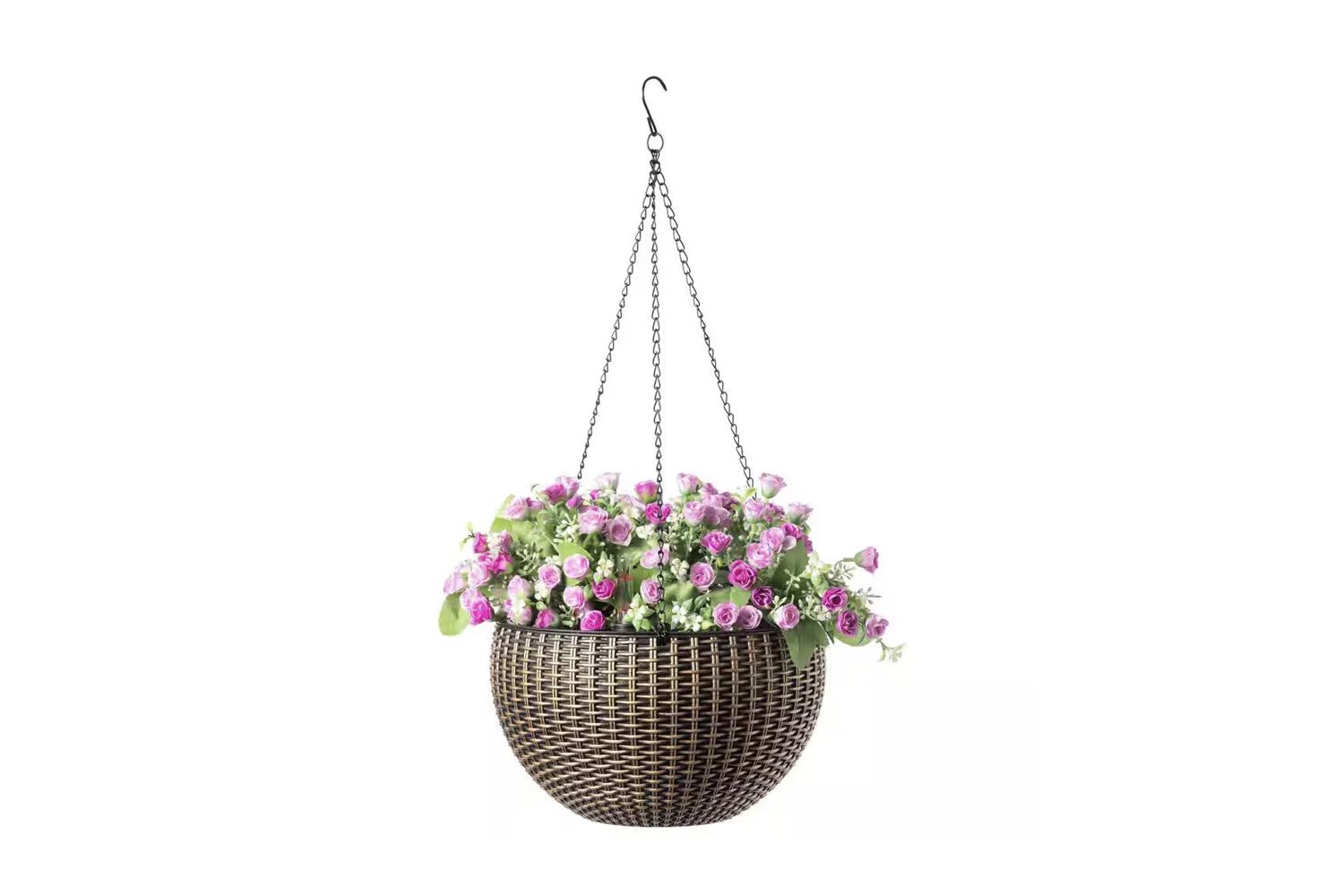
Hanging crops, particularly these stored on porches, will be troublesome to maintain watered. They’re usually underneath overhangs so that they don’t obtain rainfall, and to achieve them, chances are you’ll want to drag out a heavy step stool. A self-watering hanging planter is the proper resolution to maintain your hanging outside crops hydrated.
This selection has a basic wicker design that lends itself to nearly any area and features a chain for hanging. The planter has a gauge with most and minimal strains, so it is simple to inform if you might want to add water. There’s additionally a water port for straightforward filling and a drainage plug. Nevertheless, the port so as to add water is small, so it’s straightforward to overlook when watering.
It solely took a couple of minutes to arrange; simply insert the water-level indicator into its slot, put the liner into the outer shell, and dangle. We preferred that it had a detachable inside liner that made it simpler to plant and unplant. The planter and its chains held up nicely over the testing interval with none points.
The climate was very popular over the testing interval, so we needed to refill each different day or so because the water reservoir is small, which was a draw back of this planter. The pot does have an overflow system that may drain out water when the reservoir is just too full, which helps forestall waterlogged soil.
Product Particulars: Sizes: 10.75 inches | Materials: Polyester | Indoor/Out of doors: Out of doors
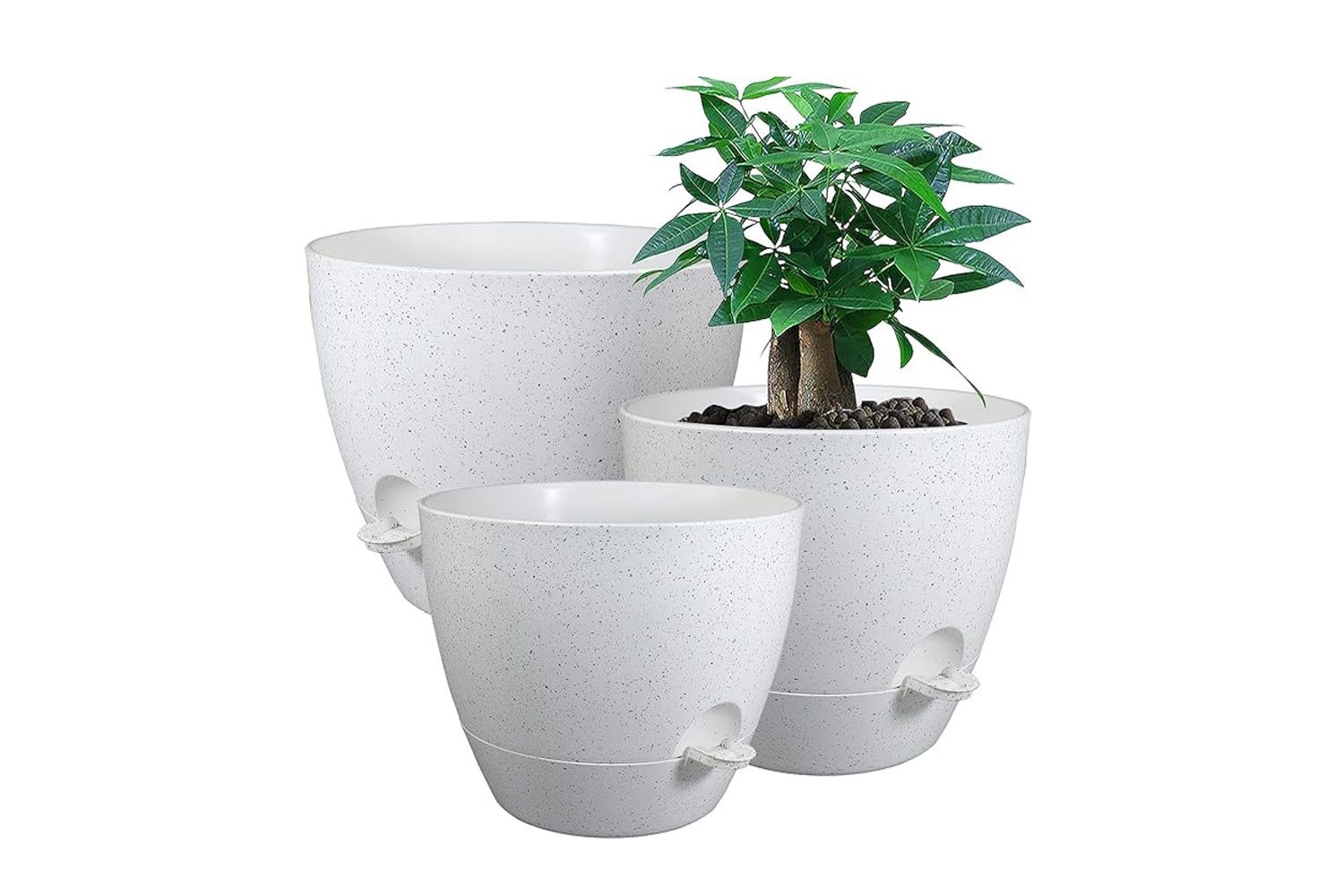
This contemporary planter arrives as a set of three. They’re product of sturdy plastic and units are available in 9 totally different strong and speckled colours so you’ll be able to choose one that may simply mix into your decor.
The planter self-waters by a wicking wire, which should be put in on the backside of the pot by feeding it by the drainage holes within the backside of the planter. A wicking wire attracts water up from the reservoir to the roots.
There is not a gauge or indicator, so to examine the water stage we needed to bodily look into the outlet between the planter and the reservoir or stick our finger in to really feel for water, which was inconvenient. Nevertheless, we liked the clip-on funnel used to pour water into the reservoir.
Drainage holes on the backside of the pot enhance airflow to the roots for plant well being. Nevertheless, we discovered it troublesome to lock the underside water reservoir into place and even dropped the reservoir just a few instances. Due to this, we advise checking that it’s locked in place earlier than filling with water.
Product Particulars: Sizes: 9,10, and 12 inches | Materials: Plastic | Indoor/Out of doors: Indoor
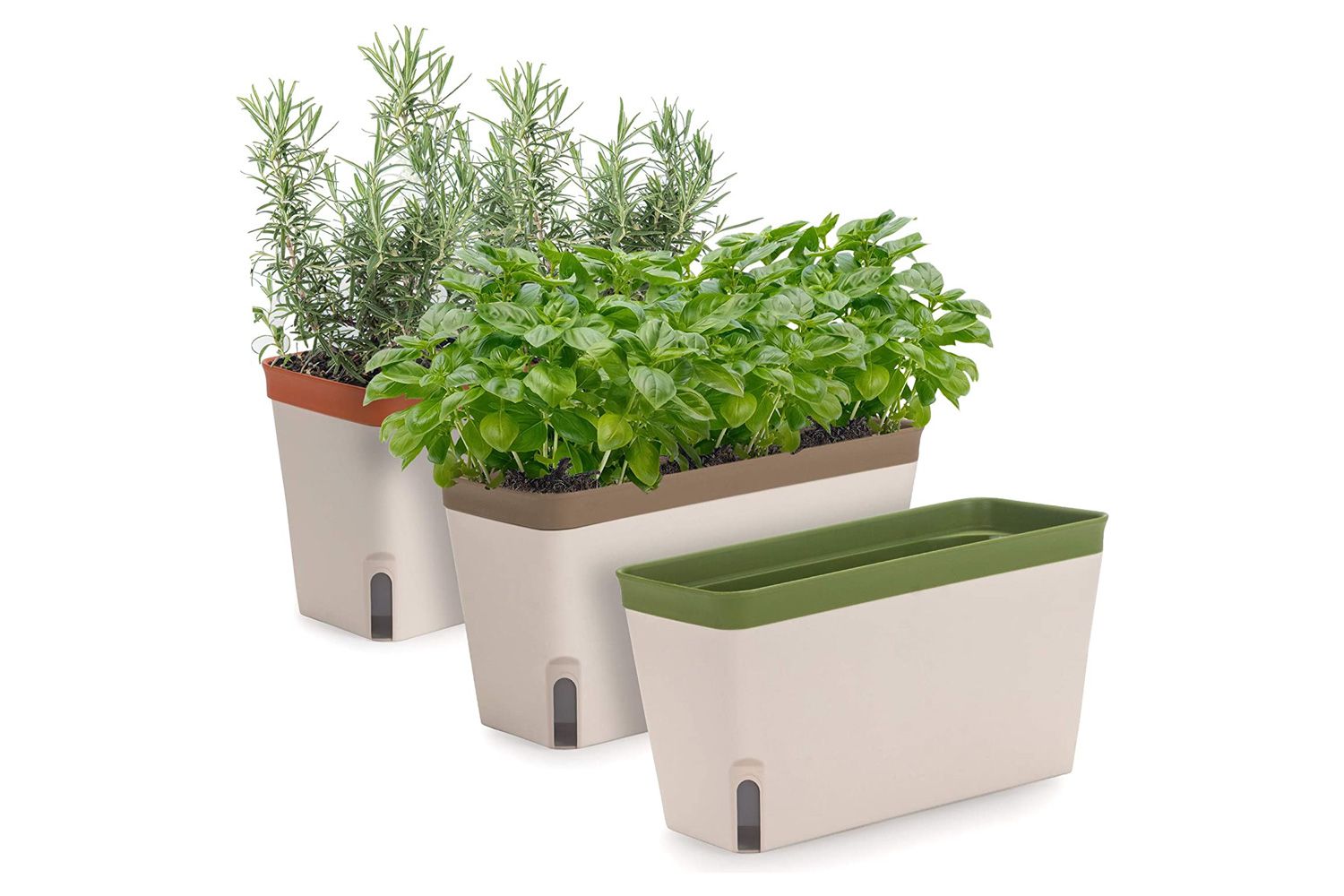
This set of three rectangular planters are designed for use on window sills and are nice for rising herbs. Herbs, resembling basil and thyme, usually require plenty of daylight and can do finest if positioned in a sunny window. The planters are light-weight so that they aren’t too heavy for a windowsill, even with a full water reservoir.
There’s a helpful nook water-filling port, which you need to use whereas the highest pot remains to be in place to rapidly fill the reservoir. There’s additionally a viewing window so you’ll be able to simply examine the water stage contained in the planter. These planters can last as long as two weeks with out watering and have two wicking strips per pot. As a result of the climate was scorching in the course of the testing interval and we had been utilizing the pots open air, the water reservoirs wanted to be refilled about each three days.
Nevertheless, the planters overfilled simply when it rained, which may result in root rot and plant injury. We additionally didn’t like that there was no straightforward strategy to drain extra water out of the planter. These elements led us to conclude that these planters are finest used indoors.
Product Particulars: Sizes: 5.5 inches | Materials: Plastic | Indoor/Out of doors: Indoor
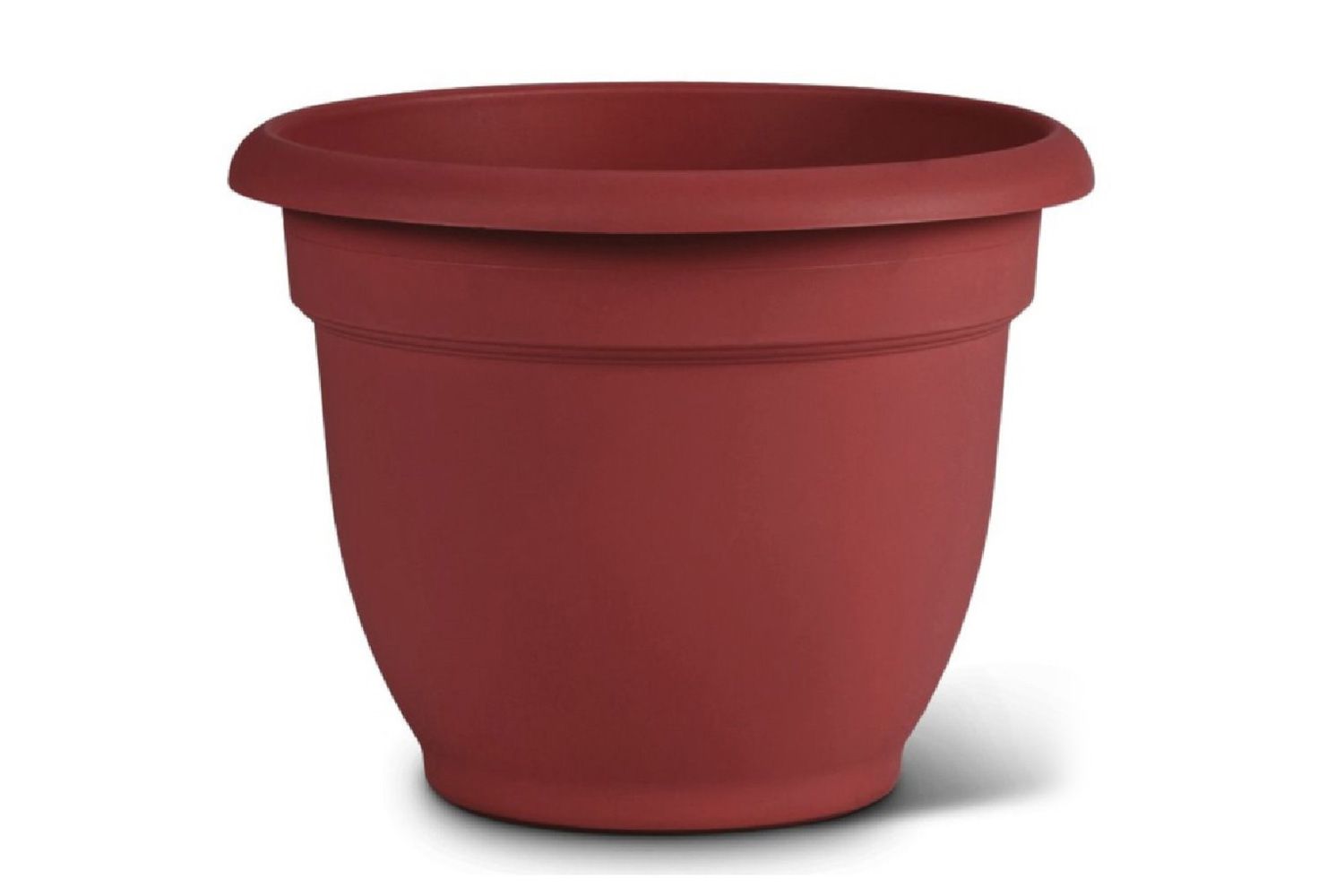
The Winston Porter Cameron planter advertises all-weather sturdiness with UV safety, and lives as much as its promise. We thought this planter carried out exceptionally nicely, lasting a whole winter open air with none cracks or fading. The plastic is coated with a plastic resin that provides it a pleasant matte end and helps shield it from the weather. This planter is available in 14 totally different colours and eight sizes so you’ll be able to customise it to suit your wants.
The self-watering disc on this planter helps forestall root rot and permits roots to obtain oxygen. Nevertheless, this planter doesn’t include pre-drilled drainage holes, so if you need drainage you will have to drill the holes your self. We opted to not drill holes and didn’t expertise any root rot or heavy overflow.
When stored outdoors, this planter not often wanted to be watered and the crops thrived. The planter is extremely low-maintenance and sturdy.
Product Particulars: Sizes: 5.25, 7, 8.5, 10.25, 13.75, 15, and 17 inches | Materials: Plastic, resin | Indoor/Out of doors: Each
The Backside Line
The earth-friendly Tierra Verde Sonata planter offers each kind and performance and is the most effective general self-watering planter. This trendy planter retains crops well-watered and is nearly indestructible, designed to withstand cracking and crumbling even in freezing temperatures.
Our Testing Course of
Our testing staff adopted a step-by-step testing course of to guage every planter, testing all of the planters for a collective complete of 5,184 hours. First, we unboxed the planters and set them up, noting if directions had been offered and the way straightforward they had been to comply with in addition to the time it took to arrange. We noticed the feel and appear of the planters and whether or not they had been product of excessive or low high quality materials.
Then, we planted the pots and positioned them in our properties, utilizing them over a interval of weeks to months. We used the water indicator if the planter had one and recorded how straightforward it was to see the water stage and refill the reservoir.
We rated the planters on the fashion and if it enhanced their area. In addition they famous if the design included drainage and air flow to forestall root rot. We frequently checked the soil moisture to see if the planter was self-watering successfully and noticed if their crops confirmed any indicators of misery or well being.
On the finish of the testing interval, we recorded any injury or weathering the planters skilled. We additionally famous our general expertise with the planter, and whether or not we thought it was definitely worth the worth.
Higher Properties & Gardens
What to Know About Self-Watering Planters Earlier than Procuring
Wicking Technique
Self-watering planters work in two alternative ways.
Some self-watering planters make the most of a wick to maintain the soil inside moist. “A wicking materials can be utilized to wick-water a plant,” Eldred Steinkopf says. “Acrylic string or yarn is the most effective wick to make use of. Cotton can be utilized, however it rots, so shouldn’t be your best option.”
She provides that wicks will be positioned within the pot, both inside the underside or up the facet, so long as not one of the string hangs from the highest of the soil, as that may wick water out of the plant. The wick then hangs out a drainage gap right into a water container, wicking up water into the potting combine.
Different self-watering pots haven’t any wick, and as an alternative the roots drink straight from a water reservoir on the backside of the pot.
On this case, “the plant roots draw the water up into the soil from the reservoir,” Eldred Steinkopf says. “Normally, there’s a tube within the pot that you just pour the water into to maintain the reservoir full. There might also be an indicator that reminds you the reservoir is empty,” she says.
Refill Frequency
The frequency with which you’ll have to refill your self-watering planter relies upon totally on the scale of the reservoir. A big reservoir that may maintain plenty of water could not must be refilled for as much as six weeks, whereas smaller reservoirs could must be refilled each few days.
Eldred Steinkopf cautions, “Simply because they’re ‘self-watering,’ bear in mind you continue to must fill the reservoirs; this can be an extended or shorter interval relying on the sunshine ranges, the kind of plant, and the temperature.”
Higher Properties & Gardens
Oxygen Circulation
Oxygen circulation across the roots is essential to forestall root rot and to have a contented, wholesome plant. Self-watering planters encourage air circulation in just a few alternative ways, together with drainage holes and slotted bottoms.
Materials
Most self-watering planters are product of artificial supplies, resembling plastic or rubber. These supplies are sometimes engineered to keep away from sun-bleaching in the summertime and cracking within the chilly winter months. Nevertheless, some plastics are higher than others, and lower-quality plastic pots will do finest indoors.
Different Self-Watering Planters We Examined
Lechuza 15392 Dice Cottage Self-Watering Planter
Whereas we liked the fashionable design and the sturdiness of this Lechuza planter, it did fall brief, because the directions for meeting had been primarily in German.
Keter City Bloomer 12.7 Gallon Raised Backyard Mattress with Self Watering Planter Field and Drainage Plug
This Keter planter upset us, because it felt flimsy and low high quality—it even fell over on a windy day and broken the crops. It was additionally unclear methods to finest use the planter, and the straightforward meeting didn’t make up for these shortcomings.
Metropolis Pickers 24,5 in. x 20.5 in. Patio Raised Backyard Mattress Develop Field Package
This planter from Metropolis Pickers had a considerably complicated set-up, and to make it extra sophisticated, the directions arrived broken and troublesome to comply with. As well as, the self-watering function didn’t work and the crops within the pot rapidly confirmed indicators of misery. We did recognize that the planter included wheels for simpler motion.
Higher Properties & Gardens
Your Questions, Answered
Are you able to overwater with self-watering pots?
Whereas outside planters which have drainage holes or overflow programs are unlikely to be over-watered, self-watering planters used indoors with their drainage holes plugged are in danger for over-watering.
“If the potting combine is just too heavy, which means it’s a combine that holds plenty of water, the plant may have an excessive amount of water round its roots,” Eldred Steinkopf says. “That is very true for inside crops—it is probably not an enormous concern outdoors.”
As well as, she says you’ll be able to over-water if the wick is just too thick and it takes up an excessive amount of water into the foundation space.
What crops will not be appropriate for self-watering pots?
Whereas most crops are appropriate for self-watering planters, Eldred-Steinkopf advises, “I might not use self-watering pots for cacti or different succulents…they’ve shallow root programs and like to not be moist all the time.”
Do self-watering planters trigger root rot?
Root rot can occur underneath many circumstances, not simply with self-watering planters. “The soil combine used within the planter can be the explanation for the rot,” Eldred Steinkopf says. “Additionally, selecting the mistaken plant or the mistaken thickness of wicking may end in root rot.”
Who We Are
This text was written by Higher Properties & Gardens contributor Rachel Ahrnsen. She is a Grasp Gardener who spent hours researching self-watering planters. To jot down this text, she utilized testing insights from BHG’s in-house testing staff. She additionally consulted Lisa Eldred Steinkopf, a houseplant skilled who runs the The Houseplant Guru weblog.
What’s BHG Recommends?
Subsequent to all the merchandise on this checklist, you might have observed our BHG Recommends seal of approval. Merchandise that earn the seal have been put by rigorous testing to ensure they’re price a spot in your house. We purchase a lot of the merchandise we take a look at ourselves, however sometimes we’re offered samples by firms if shopping for is not an possibility. In these instances, we use the identical testing standards we use to check the bought merchandise.
